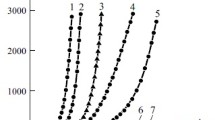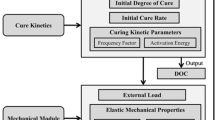Abstract
This article discusses several aspects of the curing process in polymers. First, we collect experimental data for an Araldite epoxy resin and calibrate the classical model of Kamal–Sourour. It is shown that there are strong correlations between the parameters in the material parameter identification process. Thus, a curing kinetics model with reduced number of parameters is proposed, which is calibrated to the experimental test data. Second, the model is implemented into a finite element program. Here, high-order, time-adaptive time integration schemes are chosen to treat the inherent instability resulting from the curing kinetics model. Since the curing variable determines the heat source in the heat equation, a particular finite element approach is applied. After the spatial discretization, we arrive at a large system of ordinary differential equations, where the diagonally implicit Runge–Kutta method in combination with the Multilevel-Newton method is chosen, which can be seen as an analogy to internal variable theories in nonlinear quasi-static finite element approaches. Temperature and curing-dependent heat capacity and heat conductivity are considered as well. Numerical examples and a new validation experiment conclude the investigations.
Similar content being viewed by others
References
Abliz, D., Artys, T., Ziegmann, G.: Influence of model parameter estimation methods and regression algorithms on curing kinetics and rheological modelling. J. Appl. Polym. Sci. 134(30), 45137 (2017)
Alexander, R.: Diagonally implicit Runge–Kutta methods for stiff O.D.E’.s. SIAM J. Numer. Anal. 14, 1006–1021 (1977)
Balvers, J., Bersee, H., Beukers, A., Jansen, K.: Determination of cure dependent properties for curing simulation of thick-walled composites. In: 49th AIAA, Schaumburg (2008)
Baur, H., Wunderlich, B.: About complex heat capacities and temperature-modulated calorimetry. J. Therm. Anal. Calorim. 54(2), 437–465 (1998)
Beck, J.V., Arnold, K.J.: Parameter Estimation in Engineering and Science. Wiley, New York (1977)
Boey, F., Qiang, W.: Experimental modeling of the cure kinetics of an epoxy-hexaanhydro-4-methylphthalicanhydride (MHHPA) system. Polymer 41(6), 2081–2094 (2000)
Bogetti, T.A., Gillespie Jr., J.W.: Two-dimensional cure simulation of thick thermosetting composites. J. Compos. Mater. 25(3), 239–273 (1991)
Brauner, C., Bauer, S., Herrmann, A.S.: Analysing process-induced deformation and stresses using a simulated manufacturing process for composite multispar flaps. J. Compos. Mater. 49(4), 387–402 (2015)
Chern, B.C., Moon, T.J., Howell, J.R., Tan, W.: New experimental data for enthalpy of reaction and temperature-and degree-of-cure-dependent specific heat and thermal conductivity of the Hercules 3501-6 epoxy system. J. Compos. Mater. 36(17), 2061–2072 (2002)
Coleman, B.D., Gurtin, M.E.: Thermodynamics with internal state variables. J. Chem. Phys. 47, 597–613 (1967)
Crane, L., Dynes, P., Kaelble, D.: Analysis of curing kinetics in polymer composites. J. Polym. Sci. Part C Polym. Lett. 11(8), 533–540 (1973)
Diebels, S., Ellsiepen, P., Ehlers, W.: Error-controlled Runge–Kutta time integration of a viscoplastic hybrid two-phase model. Techn. Mech. 19, 19–27 (1999)
Draper, N.R., Smith, H.: Applied Regression Analysis, 3rd edn. Wiley, New York (1998)
Droste, D., DiBenedetto, A.: The glass transition temperature of filled polymers and its effect on their physical properties. J. Appl. Polym. Sci. 13(10), 2149–2168 (1969)
Ellsiepen, P.: Zeit- und ortsadaptive Verfahren angewandt auf Mehrphasenprobleme poröser Medien. Doctoral thesis, Institute of Mechanics II, University of Stuttgart, report no. II-3 (1999)
Ellsiepen, P., Hartmann, S.: Remarks on the interpretation of current non-linear finite-element-analyses as differential–algebraic equations. Int. J. Numer. Methods Eng. 51, 679–707 (2001)
Forrest, J., Dalnoki-Veress, K., Stevens, J., Dutcher, J.: Effect of free surfaces on the glass transition temperature of thin polymer films. Phys. Rev. Lett. 77(10), 2002 (1996)
Fournier, J., Williams, G., Duch, C., Aldridge, G.A.: Changes in molecular dynamics during bulk polymerization of an epoxide- amine system as studied by dielectric relaxation spectroscopy. Macromolecules 29(22), 7097–7107 (1996)
Fox, T.G., Loshaek, S.: Influence of molecular weight and degree of crosslinking on the specific volume and glass temperature of polymers. J. Polym. Sci. Part A Polym. Chem. 15(80), 371–390 (1955)
Fritzen, P.: Numerische Behandlung nichtlinearer Probleme der Elastizitäts- und Plastizitätstheorie. Doctoral thesis, Department of Mathematics, University of Darmstadt (1997)
Gill, P., Sauerbrunn, S., Reading, M.: Modulated differential scanning calorimetry. J. Therm. Anal. 40(3), 931–939 (1993)
Hairer, E., Wanner, G.: Solving Ordinary Differential Equations II, 2nd edn. Springer, Berlin (1996)
Hairer, E., Norsett, S.P., Wanner, G.: Solving Ordinary Differential Equations I, 2nd edn. Springer, Berlin (1993)
Hamkar, A.W.: Eine iterationsfreie Finite-Elemente Methode im Rahmen der finiten Thermoviskoelastizität. Phd-thesis, report no. 1/2013, Institute of Applied Mechanics, Clausthal University of Technology, Clausthal-Zellerfeld (2013)
Hamkar, A.W., Hartmann, S.: Theoretical and numerical aspects in weak-compressible finite strain thermo-elasticity. J. Theor. Appl. Mech. 50, 3–22 (2012)
Hamkar, A.W., Hartmann, S., Rang, J.: A stiffly accurate Rosenbrock-type method of order 2 applied to FE-analyses in finite strain viscoelasticity. Appl. Numer. Math. 62(12), 1837–1848 (2012)
Hartmann, S.: Computation in finite strain viscoelasticity: finite elements based on the interpretation as differential–algebraic equations. Comput. Methods Appl. Mech. Eng. 191(13–14), 1439–1470 (2002)
Hartmann, S.: A remark on the application of the Newton–Raphson method in non-linear finite element analysis. Comput. Mech. 36(2), 100–116 (2005)
Hartmann, S.: Comparison of the multiplicative decompositions \({\bf F}={\bf F}_\varTheta {\bf F}_{M}\) and \({\bf F}={\bf F}_{M} {\bf F}_\varTheta \) in finite strain thermo-elasticity. Technical Report Series Fac3-12-01, Faculty of Mathematics/Computer Sciences and Mechanical Engineering, Clausthal University of Technology (Germany) (2012)
Hartmann, S., Hamkar, A.W.: Rosenbrock-type methods applied to finite element computations within finite strain viscoelasticity. Comput. Methods Appl. Mech. Eng. 199(23–24), 1455–1470 (2010)
Hartmann, S., Rothe, S.: A rigorous application of the method of vertical lines to coupled systems in finite element analysis. In: Ansorge, R., Bijl, H., Meister, A., Sonar, T. (eds.) Recent Developments in the Numerics of Nonlinear Hyperbolic Conservation Laws, Notes on Numerical Fluid Mechanics and Multidisciplinary Design, vol. 120, pp. 161–175. Springer, Berlin (2013)
Hartmann, S., Duintjer Tebbens, J., Quint, K.J., Meister, A.: Iterative solvers within sequences of large linear systems in non-linear structural mechanics. ZAMM J. Appl. Math. Mech. 89(9), 711–728 (2009)
Haupt, P.: Continuum Mechanics and Theory of Materials, 2nd edn. Springer, Berlin (2002)
Heuser, H.: Lehrbuch der Analysis Teil II, 7th edn. Teubner, Stuttgart (1992)
Hossain, M., Steinmann, P.: Continuum physics of materials with time-dependent properties: reviewing the case of polymer curing. Adv. Appl. Mech. 48, 141–259 (2015)
Hoyer, W., Schmidt, J.W.: Newton-type decomposition methods for equations arising in network analysis. ZAMM Z. Angew. Math. Mech. 64, 397–405 (1984)
Hughes, T.J.R.: The Finite Element Method. Prentice-Hall, Englewood Cliffs (1987)
Huntsman: Advanced Materials Araldite LY 556 / Aradur 917 / Accelerator DY 070. Huntsman Advanced Materials GmbH, Basel, Switzerland (2007)
Johnston, A.A.: An integrated model of the development of process-induced deformation in autoclave processing of composite structures. Ph.D. thesis, University of British Columbia (1997)
Kamal, M.R.: Thermoset characterization for moldability analysis. Polym. Eng. Sci. 14(3), 231–239 (1974)
Karkanas, P.I., Partridge, I.K.: Cure modeling and monitoring of epoxy/amine resin systems. I. Cure kinetics modeling. J. Appl. Polym. Sci. 77(7), 1419–1431 (2000)
Klan, H., Thess, A.: Wärmeübertragung bei freier Konvektion: Außenströmungen. In: VDI-Wärmeatlas, Springer, chap F2, pp. 753–764 (2006)
Krämer, S., Rothe, S., Hartmann, S.: Homogeneous stress–strain states computed by 3D-stress algorithms of FE-codes: application to material parameter identification. Eng. Comput. 31, 141–159 (2015)
Krantz, S.G., Parks, H.R.: The Implicit Function Theorem, 1st edn. Birkhäuser, Boston (2003)
Kreisselmeier, G., Steinhauser, R.: Systematische Auslegung von Reglern durch Optimierung eines vektoriellen Gütekriteriums/Systematic controller design by optimization of a vector performance index. at-Automatisierungstechnik 27(1–12):76–79 (1979)
Laidler, K.J.: The development of the Arrhenius equation. J. Chem. Educ. 61(6), 494 (1984)
Landgraf, R.: Modellierung und Simulation der Aushärtung polymerer Werkstoffe. Ph.D. thesis, Technische Universität Chemnitz. http://nbn-resolving.de/urn:nbn:de:bsz:ch1-qucosa-187720 (2015)
Landgraf, R., Ihlemann, J., Kolmeder, S., Lion, A., Lebsack, H., Kober, C.: Modelling and simulation of acrylic bone cement injection and curing within the framework of vertebroplasty. ZAMM-J. Appl. Math. Mech./Z. Angew. Math. Mech. 95(12), 1530–1547 (2015)
Lang, J., Verwer, J.: ROS3P—an accurate third-order Rosenbrock solver designed for parabolic problems. BIT 41, 731–738 (2001)
Leistner, C., Hartmann, S., Wittrock, J., Bode, K.: Shrinkage behavior of araldite epoxy resin using Archimedes’ principle. Polym. Test. 67, 409–416 (2018)
Liebl, C., Johlitz, M., Yagimli, B., Lion, A.: Three-dimensional chemo-thermomechanically coupled simulation of curing adhesives including viscoplasticity and chemical shrinkage. Comput. Mech. 49(5), 603–615 (2012)
Lion, A., Dippel, B., Liebl, C.: Thermomechanical material modelling based on a hybrid free energy density depending on pressure, isochoric deformation and temperature. Int. J. Solids Struct. 51(3), 729–739 (2014)
Loshaek, S., Fox, T.: Cross-linked polymers. I. Factors influencing the efficiency of cross-linking in copolymers of methyl methacrylate and glycol dimethacrylates. J. Am. Chem. Soc. 75(14), 3544–3550 (1953)
Lu, S., Pister, K.: Decomposition of deformation and representation of the free energy function for isotropic thermoelastic solids. Int. J. Solids Struct. 11, 927–934 (1975)
Mijovic, J., Wang, H.T.: Modeling of processing of composites. Part II—temperature distribution during cure. SAMPE J. 24(2), 42–55 (1988)
Nielsen, L.E.: Cross-linking-effect on physical properties of polymers. J. Macromol. Sci. Part C 3(1), 69–103 (1969)
Parker, W., Jenkins, R., Butler, C., Abbott, G.: Flash method of determining thermal diffusivity, heat capacity, and thermal conductivity. J. Appl. Phys. 32(9), 1679–1684 (1961)
Quint, K.J., Hartmann, S., Rothe, S., Saba, N., Steinhoff, K.: Experimental validation of high-order time-integration for non-linear heat transfer problems. Comput. Mech. 48, 81–96 (2011)
Rabbat, N.B.G., Sangiovanni-Vincentelli, A.L., Hsieh, H.Y.: A multilevel Newton algorithm with macromodeling and latency for the analysis of large-scale nonlinear circuits in the time domain. IEEE Trans. Circuits Syst. 26, 733–740 (1979)
Ramos, J., Pagani, N., Riccardi, C., Borrajo, J., Goyanes, S., Mondragon, I.: Cure kinetics and shrinkage model for epoxy-amine systems. Polymer 46(10), 3323–3328 (2005)
Reading, M., Elliott, D., Hill, V.: A new approach to the calorimetric investigation of physical and chemical transitions. J. Therm. Anal. Calorim. 40(3), 949–955 (1993)
Rothe, S., Hamkar, A.W., Quint, K.J., Hartmann, S.: Comparison of diagonal-implicit, linear-implicit and half-explicit Runge–Kutta methods in non-linear finite element analyses. Arch. Appl. Mech. 82(8), 1057–1074 (2012)
Ruiz, E., Trochu, F.: Numerical analysis of cure temperature and internal stresses in thin and thick RTM parts. Compos. Part A Appl. Sci. Manuf. 36(6), 806–826 (2005)
Schawe, J.: A description of chemical and diffusion control in isothermal kinetics of cure kinetics. Thermochim. Acta 388(1), 299–312 (2002)
Schwarz, H.R., Köckler, N.: Numerische Mathematik. Springer, Berlin (2011)
Simo, J.C., Taylor, R.L.: Consistent tangent operators for rate-independent elastoplasticity. Comput. Methods Appl. Mech. Eng. 48, 101–118 (1985)
Urbaniak, M.: A relationship between the glass transition temperature and the conversion degree in the curing reaction of the EPY epoxy system. Polimery 56(3), 240–243 (2011)
Van Assche, G., Van Hemelrijck, A., Rahier, H., Van Mele, B.: Modulated temperature differential scanning calorimetry: cure, vitrification, and devitrification of thermosetting systems. Thermochim. Acta 304, 317–334 (1997)
Wriggers, P.: Nichtlineare Finite-Elemente Methoden. Springer, Berlin (2001)
Zhang, J., Xu, Y., Huang, P.: Effect of cure cycle on curing process and hardness for epoxy resin. Express Polym. Lett. 3(9), 534–541 (2009)
Acknowledgements
We gratefully acknowledge our colleagues at Clausthal University of Technology Dr. J. Wittrock and K. Bode for their support in the shrinkage experiments. Furthermore, we would like to thank Marco Löffelholz for his support in performing some validation experiments
Author information
Authors and Affiliations
Corresponding author
Additional information
Communicated by Johlitz, Laiarinandrasana and Marco.
Publisher's Note
Springer Nature remains neutral with regard to jurisdictional claims in published maps and institutional affiliations.
Rights and permissions
About this article
Cite this article
Leistner, C., Hartmann, S., Abliz, D. et al. Modeling and simulation of the curing process of epoxy resins using finite elements. Continuum Mech. Thermodyn. 32, 327–350 (2020). https://doi.org/10.1007/s00161-018-0708-9
Received:
Accepted:
Published:
Issue Date:
DOI: https://doi.org/10.1007/s00161-018-0708-9




